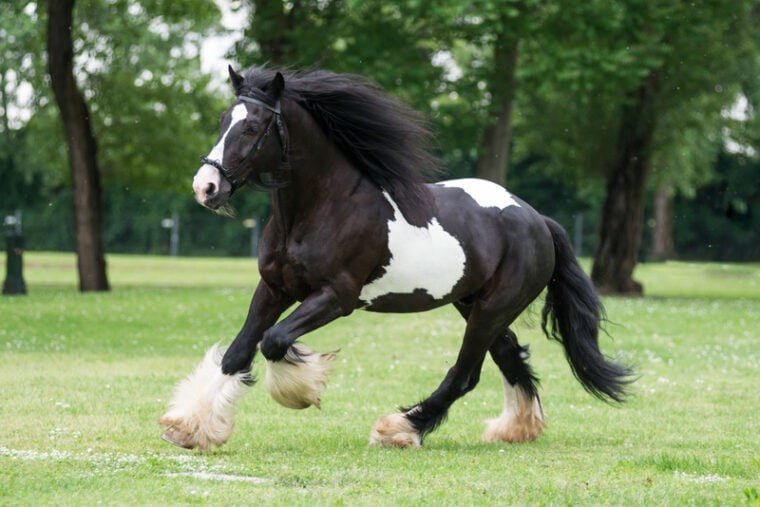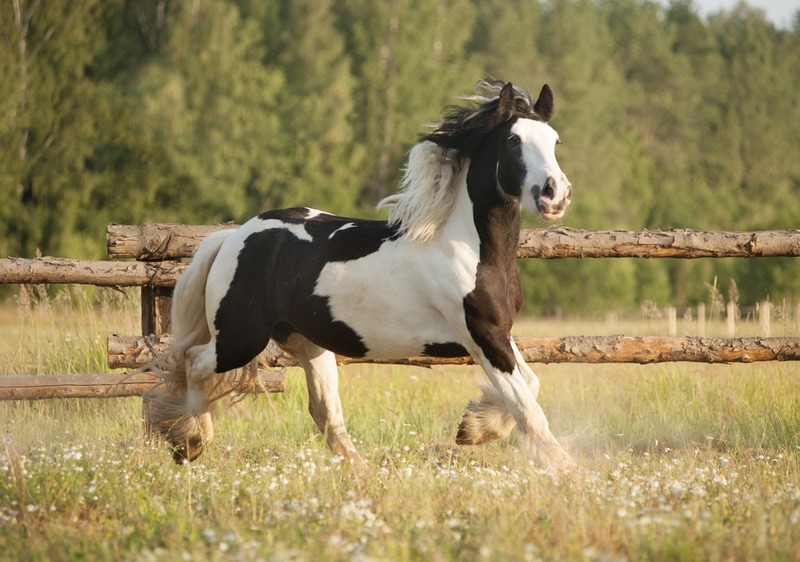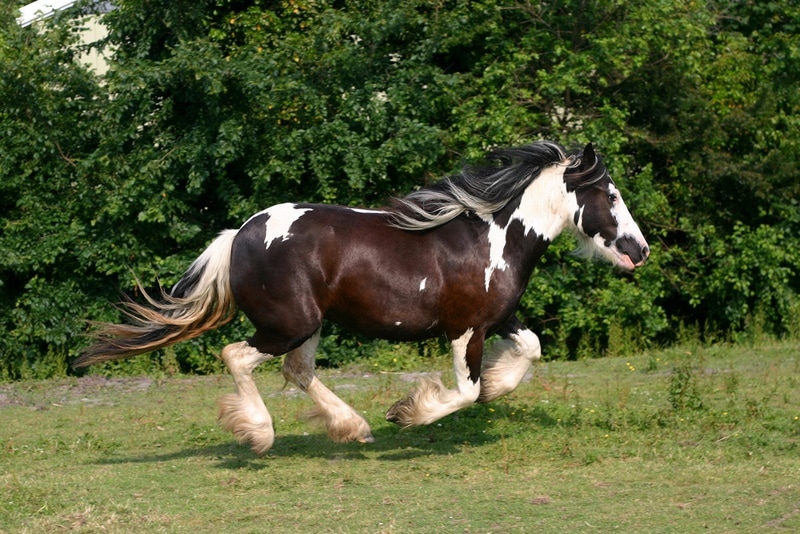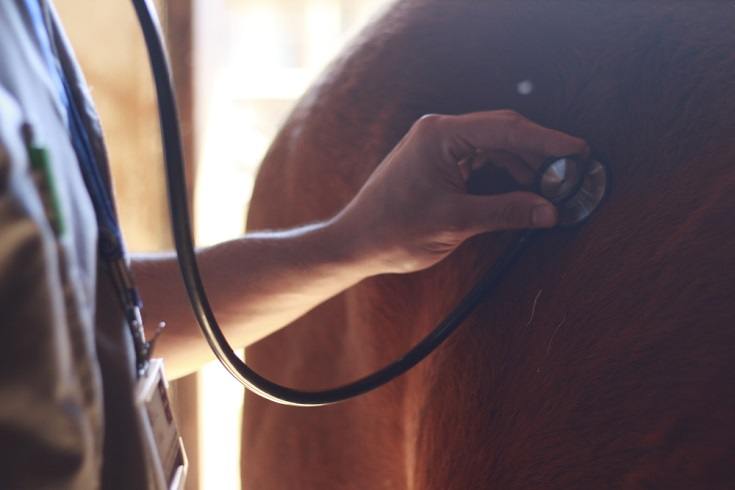
Click to Skip Ahead
Often referred to as a “people-sized draft horse,” the Gypsy Vanner is a striking breed with a sturdy build, wonderful temperament, and beautifully flowing mane, tail, and feathers. As a relatively new breed, these horses were selectively bred for over 50 years to become the unique, mystical breed we admire today.
Only arriving in America 27 years ago, those of us in the United States aren’t as familiar with this UK native. There is much to be learned and revered about the Gypsy Vanner, so keep reading for a more in-depth look into the development, history, and characteristics of this magnificent breed.
| Care Level | Moderate |
| Temperature | All climates |
| Temperament | Docile, friendly, gentle |
| Colors | Any Color |
| Lifespan | 25–30 years |
| Weight | 1,100 to 1,700 pounds |
| Height | 13–16 hands |
The beautiful, elegant Gypsy Vanner gets its name from the fact that they were the vanner horses for the Gypsies. Originally bred to pull caravans, these horses were developed from various draft breeds and English ponies, they reach both the height and weight of your average horse, ranging from 13 to 16 hands and 1,100 and 1,700 pounds.
They are best known for their unique beauty and incredible temperament, as they are very friendly, loving, docile, and easy to work with. While they come in allx coat colors and patterns, they are best known for the black and white tobiano look with their stunning manes, tails, and feathering.
Gypsy Vanner Breed Characteristics
What Are These Horses Used For?
Originally bred to pull the Gypsy wagon, these horses are now used throughout all disciplines. Not only will you see them pulling carts and carriages, but also competitive driving, dressage, jumping, ranch work, recreational riding, and western pleasure.

Where Did These Horses Originate From?
The Gypsy Vanner got its beginnings thanks to the Romanichal travelers, also known as the English Gypsies. Their aim was to create a horse that was strong enough to pull the wagons, or vardos, but they are also sound, gentle, easy to train, and good natured. While pulling the vardos may have been their primary job, they were always in company of their caretakers and were often considered part of the family.
While different breeds were incorporated into the selective breeding of these unique horses, the foundation of the breed was developed around a select few. The Clydesdale, Shire, and Friesian breeds were all used to develop the Gypsy Vanner’s strength and sturdy build, while the Dales and Fell ponies were used to reduce their overall size and free flowing gait.
The Gypsy Vanner was not recognized as a breed until 1996, which was the year they were first brought into America. This prompted the development of the breed registry and an official breed society, the Gypsy Vanner Horse Society.
Temperament & Intelligence of the Gypsy Vanner
In addition to their natural, breathtaking beauty, these horses also have incredible temperaments. As mentioned above, these horses were bred to be well mannered, friendly, and easy to train. They have a very calm, loving, and pleasant demeanor and will bond closely with their people.
Because of their wonderful disposition, the Gypsy Vanner is an excellent partner for all experience levels. They make fantastic horses for families with children, not only because of their excellent temperaments but also because their intelligence and trainability make them suitable across all disciplines.
Appearance & Varieties
When fully grown, the Gypsy Vanner will reach between 13 and 16 hands high and will often weigh between 1,100 and 1,700 pounds. They have shorter backs in proportion to their overall body size with broad chests and round hips.
They have a long, flowing mane and tail with abundant feathering which are among their most unique characteristics. The mane and tail can vary in texture from straight and smooth to silky and wavy but are meant to be long and flowing regardless.
The feathering, which is the excessively long hair on the lower legs, starts at the knee and hock and extends down over the hooves on all four legs. Not only does this add to their majestic beauty, but it also helps protect the legs from the elements.
Another one of the breed’s most distinguished traits is their gait. They have an unrestricted, free style of moving with their knees and hocks synchronized and the ability to extend their gait upon request. Their trot is considered a trademark of the Gypsy Vanner’s image.
The breed standard is not based on color and all coat colors and patterns are acceptable for registry; however, they are known for the tobiano coat pattern, especially the black and white piebald. According to the Gypsy Vanner Horse Society, their coat pattern descriptions can be broken down as follows:

Things to Know When Owning a Gypsy Vanner:
Habitat & Stable Requirements 🌾
All horses need shelter from the elements and must have somewhere to go to get out of the sun, wind, rain, or snow. Suitable shelters include walk-in sheds or a secure stable. Stables must be size appropriate, with average size horses needing 12 feet by 12 feet of stable space. Gypsy Vanners on the larger side would benefit more from 14 feet by 14 feet of stable space to make them more comfortable and give them more room to move.
Since draft horses and related breeds often have a harder time regulating their body temperature in the hot summer months, it is very important that the Gypsy Vanner always has fresh clean water available and has areas in the pasture that offer plenty of shade.
Gypsy Vanners may be cold tolerant with their heavy bodies and large muscle mass, but they should still have adequate shelter from winter conditions. Temperature controls should be set up in the barn to ensure the inside does not become too hot or too cold.
Food & Diet Requirements 🥕
The Gypsy Vanner requires a balanced diet that is suitable for their age, size, and activity level. Proper nutrition is incredibly important for the breed and can be crucial in managing certain health conditions they are predisposed to.
Gypsy Vanners have also been known to have a slower metabolism, meaning they often don’t require as much food to maintain a healthy weight, though it can also make it much easier to gain weight if they are overfed and do not get adequate exercise.
All horses are grazers by nature and will need access to small meals throughout the entire day. Their digestive systems are not designed to eat large meals in one sitting, so ensure they have a constant supply of high-quality hay and grass for munching.
Always check to ensure their food is clean and free of mold. Ask your veterinarian about the best commercial feeds and/or supplements that are needed to balance their diet. In addition to food, they should have access to fresh, clean water and a salt lick.
Exercise 🐎
Any horse is going to require a decent amount of physical activity each day to maintain fitness and overall health. While domesticated horses may not put in as many miles as wild horses at 20 to 50 miles per day, they still need to be exercised daily and since Gypsy Vanners have a slower than usual metabolism, it makes it very important to keep them active.
The best type of exercise is the slow steady movement that comes naturally with grazing with occasional bursts of higher intensity and speed. Most horses will do this naturally when turned out in the pasture with room to roam. For those with more limited pasture, make sure you take time to exercise your horse by hand walking, lunging, or riding.

Training 🐴
Since the breed was developed specifically for trainability, they are incredibly intelligent and easy to train. Keep in mind that each horse is an individual, so they will each have their own unique personality traits.
Like all horses, the Gypsy Vanner is well in tune with your energy, so it’s important to always build a bond and develop trust as the first step in training. Once you’ve established a relationship, you can then begin groundwork, desensitization, and getting them used to the saddle or any other area of discipline you desire.
Even with a docile temperament, beginners should consider contacting an experienced trainer for horses that have not had any training yet.
Grooming 🧽
The Gypsy Vanner should be brushed daily and before and after each activity that involves equipment. While daily grooming is a must for any horse, it is imperative that the Gypsy Vanner’s mane, tail, and leg feathering are cleaned and groomed frequently to prevent staining, tangles, and matting.
It’s also very important to keep this breed well groomed since their excess hair can trap moisture and debris, easily leading to pastern dermatitis. Frequent grooming will allow you to check for any signs of skin infection, inflammation, or growths that this breed is prone to.
Their hooves should be kept trimmed regularly either by the owner or a professional farrier. Hoof health is important for their overall health, as healthy hooves allow them to maintain proper stability and functionality.
Lifespan & Health Conditions 🏥
Like most horses, the Gypsy Vanner has an average lifespan of 25 to 30 years. While they are susceptible to some of the most common equine health conditions, they are prone to some breed specific conditions as well. Responsible breeding is the key to avoiding certain health conditions, so it’s important to thoroughly vet breeders.
Serious Conditions:
PSSM: Draft breeds and breeds descended from them are susceptible to a genetic condition known as polysaccharide storage myopathy, or PSSM for short. This condition occurs from abnormal glycogen storage in the muscle, which leads to muscle cramping and episodes of tying up.
Studies have shown that the GYS1 gene mutation is responsible for PSSM and while there is no cure for PSSM, diet and nutritional support has been shown to manage it.
Chronic Progressive Lymphedema: Chronic Progressive Lymphedema, or CPL, is a debilitating and incurable condition that results from impaired lymph flow that is common among draft horse breeds. Because of their close relation to draft horses, the Gypsy Vanner is also susceptible the disease.
CPL is progressive and occurs from a buildup of the lymphatic fluid in the lower extremities. Management under veterinary supervision may help slow progression, but the condition often results in lameness and limb disfigurement.
FIS: Foal immunodeficiency syndrome, or FIS for short, is an inherited disease that causes impaired immune function and fatal anemia in the affected foals. This is a genetic mutation found primarily in the Fell and Dales Ponies, which is why the Gypsy Vanner is also susceptible.

Minor Conditions:
Hyperkeratosis/ Mallenders and Sallenders
Hyperkeratosis refers to the overproduction of keratin. Since keratin is responsible for the long flowing mane, tail, and feathering of the Gypsy Vanner, it makes hyperkeratosis a risk factor for the breed. Too much keratin can lead to growths called mallenders and sallenders.
These crusty scabs can form on both the fronts and backs of the legs and should be removed right away to prevent bacterial or fungal infections from occurring. This is why grooming is so important, as owners should frequently check the Gypsy Vanner for any signs of these growths.
Infections and reoccurring mallenders and sallenders can lead to extreme discomfort, inflammation, lesions, and lymphedema. Maggot infestations can also occur in the lesions during the warmer weather months without prompt treatment.
Male vs Female
Stallions
A stallion is an intact male and while they can be great horses and trained for various disciplines, they are often very territorial and aggressive. Stallions are hormonal and will be more difficult to handle than mare or geldings.
They are not recommended for novice owners and must be kept separate from other horses due to their behavior and the fact that they will try to mate with any mares around. Overall, training and managing stallions is much more difficult when compared to both mares and geldings.
Geldings
Geldings are castrated male horses and they tend to be calmer and much easier to handle, especially when compared to stallions. Since they are not affected by hormonal fluctuations, they don’t suffer from mood swings and typically have a consistent demeanor and you will know what to expect from your individual horse.
Geldings are a very popular choice for all disciplines since they tend to be easier to train and manage. For this reason, they make the best option for most people but especially beginners.
Mares
Mares, or female horses may be slightly smaller than males but are typically just as strong capable. They are often more independent but less aggressive and territorial than stallions. They can make great partners across all disciplines.
While they can be suitable for beginners, they are more prone to moodiness than geldings because of their hormonal fluctuations. For this reason, you may not always know what kind of attitude to expect from a mare, though it varies by individual.
Mares will go through consistent heat cycles, and if they are to become pregnant, they will have physical limitations and require more extensive care throughout the pregnancy and rearing of the foal.
3 Little-Known Facts About the Gypsy Vanner
1. Their Jobs Were First Done by Mules
Vardo living began for the Romanichal travelers around 1850, but up until the mid-1900s they used mules and other horses to pull the caravans. It wasn’t until after WWII that the Gypsy Vanner breed began to truly take shape.
2. Some Gypsy Vanners May Grow a Mustache
We already know that Gypsy Vanners have a lot of long, flowy hair, but did you also know they are one of the horse breeds, along with the Friesian and Haflinger, that are most likely to grow a mustache? Not every Gypsy Vanner will grow a mustache, and it doesn’t matter whether they are male or female. This extra hair growth is completely normal and even serves a purpose by providing extra sensory input, much like a cat’s whiskers.
3. You Can Visit and Tour a Gypsy Vanner Farm in Ocala, Florida
Gypsy Gold Farm in Ocala, Florida is a wonderful place to visit to get up close and personal with these beautiful horses. They offer farm tours that allow visitors to learn about these magnificent horses, and considering how rare the breed is in the United States, it makes it a must visit for Gypsy Vanner lovers.

Final Thoughts
The Gypsy Vanner was developed by the Romanichal travelers to pull their vardos, but the breed now excels in many disciplines. They were created to be the image of a small draft horse complete with power, stamina, and a wonderful personality. They are quite rare outside of the United Kingdom, so they are often costly and difficult to find in the United States. They may be a newer breed, but their unique beauty and incredible temperaments are sure to draw in any horse lover.
Featured Image Credit: Nicole Ciscato, Shutterstock








